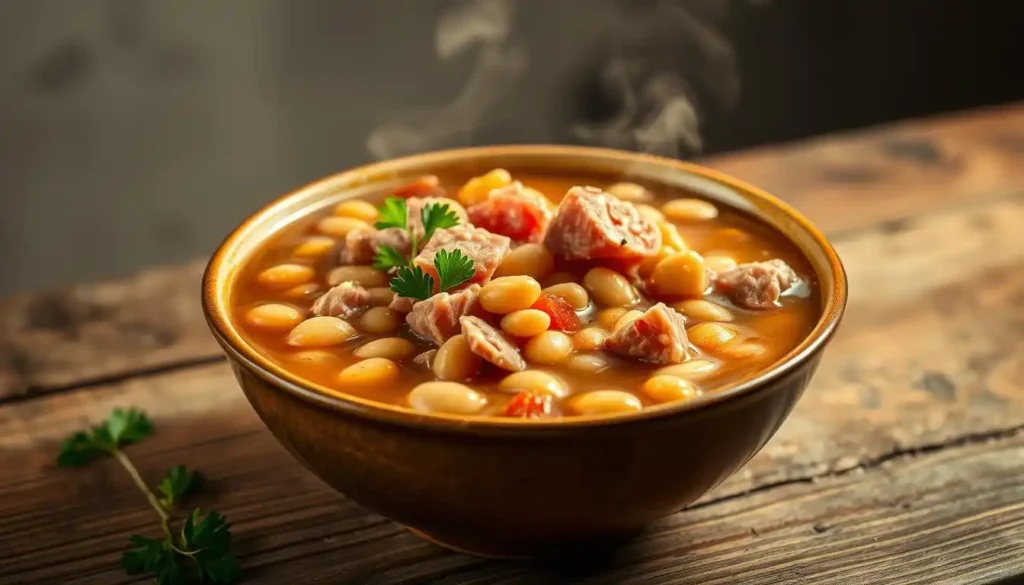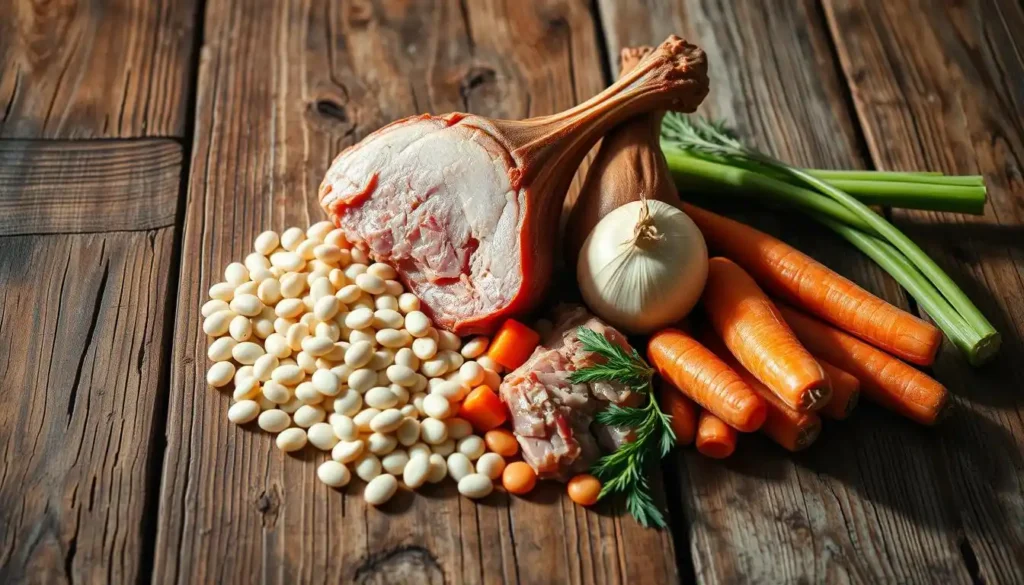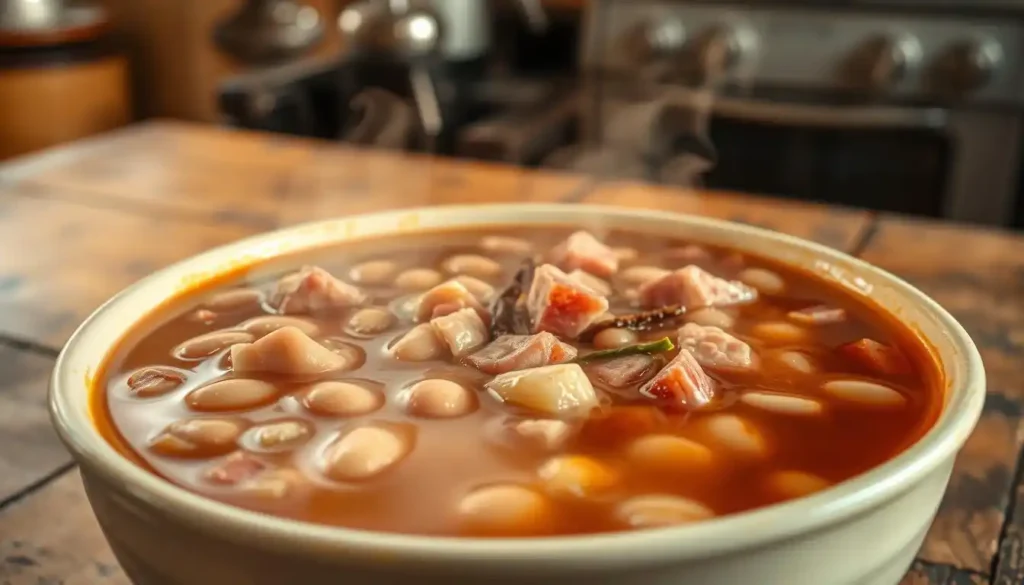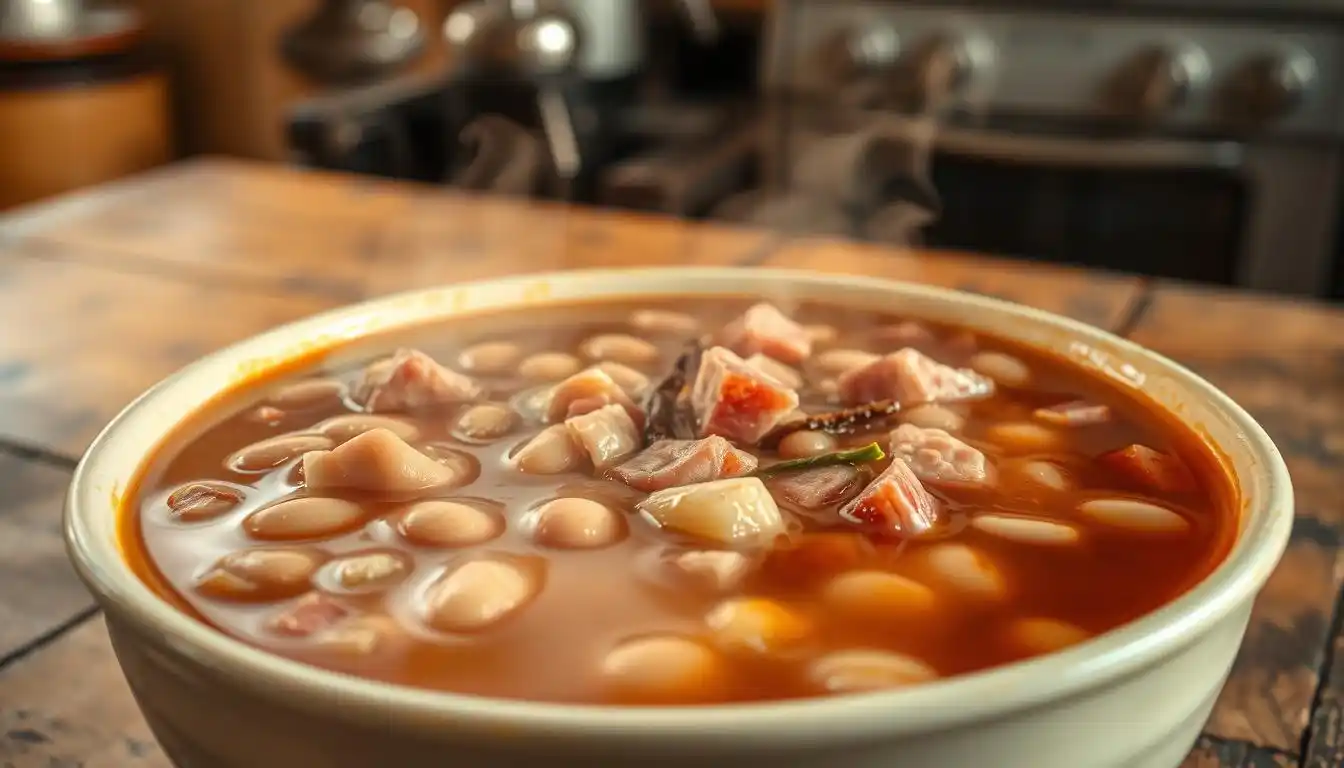There’s something special about a warm, comforting bowl of ham and bean soup that can instantly lift your spirits. As the weather cools down, this hearty dish becomes a staple in many households across the United States.
You might be wondering what makes this bean soup with ham recipe so beloved. The secret lies in its simplicity and the rich flavors that come together to create a truly satisfying meal. In this article, we’ll guide you through the process of making the perfect ham and bean soup, sharing tips and tricks along the way.
Table of Contents
Key Takeaways
- Learn how to make a delicious and comforting ham and bean soup.
- Discover the key ingredients that make this dish a staple in many American households.
- Get tips on customizing the recipe to suit your taste preferences.
- Understand the importance of using quality ingredients for the best flavor.
- Find out how to make this recipe your own with simple variations.
The Comfort and Appeal of Ham and Bean Soup
For many, ham and bean soup is more than just a meal; it’s a nostalgic reminder of home-cooked meals from childhood. This comforting dish has been a staple in many households, providing warmth and nourishment. Let’s explore the history behind this beloved soup and why it remains a family favorite.
A Brief History of This Classic Dish
Ham and bean soup has its roots in traditional European cuisine, where beans were a staple ingredient due to their availability and nutritional value. Early settlers in America adopted this recipe, incorporating locally available ham. The simplicity and heartiness of the dish made it a practical choice for many families.
The evolution of ham and bean soup in the United States was influenced by various cultural and economic factors. During times of economic hardship, beans provided a cheap source of protein, while ham added flavor. This combination became a cornerstone of American comfort food.
| Period | Influence on Ham and Bean Soup | Key Ingredients |
|---|---|---|
| Colonial Era | Introduction of beans and ham by European settlers | Beans, salted ham, vegetables |
| 19th Century | Regional variations emerged, incorporating local ingredients | Smoked ham, onions, carrots |
| 20th Century | Increased availability of pre-cooked ham and canned beans simplified preparation | Pre-cooked ham, canned navy beans |
Why This Soup Remains a Family Favorite
Despite the rise of more complex and modern recipes, ham and bean soup remains a favorite due to its comforting and familiar flavors. The dish is often associated with warmth and care, as it’s typically made with love and served during family gatherings.
The versatility of ham and bean soup is another reason for its enduring popularity. You can customize it with various ingredients, such as different types of beans or additional vegetables, making it suitable for a wide range of tastes and dietary needs.

As we continue to explore the world of ham and bean soup, we’ll delve into the essential ingredients that make this dish so special, and how you can prepare it to suit your family’s preferences.
Essential Ingredients for the Perfect Ham and Bean Soup
Creating the perfect ham and bean soup starts with selecting the right ingredients. The quality and type of these ingredients can significantly impact the flavor and texture of your soup.
Choosing the Right Beans
The type of beans you choose can greatly affect the character of your ham and bean soup. While traditional recipes often call for navy beans, other varieties like Great Northern, cannellini, or even pinto beans can be used to create different flavor profiles.
- Navy beans are small, white, and have a mild flavor, making them a classic choice.
- Great Northern beans are larger and have a slightly firmer texture, offering a slightly different mouthfeel.
- Cannellini beans are Italian flat beans that add a creamy texture and a slightly nutty flavor.

Ham Options: Bone-In vs. Pre-Cooked
The choice between bone-in ham and pre-cooked ham can significantly impact the flavor of your bean soup with ham recipe. Bone-in ham, particularly when it’s a leftover ham bone, can add a rich, deep flavor to your soup.
Using a ham bone is ideal for creating a ham and bean soup with ham bone that is full of flavor. However, pre-cooked ham can be a convenient alternative that still yields delicious results.
Vegetables and Aromatics That Enhance Flavor
In addition to beans and ham, various vegetables and aromatics play a crucial role in enhancing the flavor of your soup. Onions, garlic, carrots, and celery are common additions that add depth and complexity.
Other aromatics like bay leaves, thyme, and parsley can be used to create a more nuanced flavor profile. You can also add other vegetables like diced potatoes or leeks to make the soup more hearty.
Preparing Your Beans for the Best Texture
Achieving the perfect texture in your ham and bean soup starts with properly preparing your beans. The texture of your beans can make or break the overall quality of your soup, making this step crucial.
Bean preparation typically involves soaking, which can significantly impact the final texture of your soup. Soaking helps to rehydrate the beans, making them cook more evenly and potentially reducing cooking time.
Soaking Methods: Overnight vs. Quick Soak
There are primarily two soaking methods: overnight soaking and quick soaking. Overnight soaking involves soaking the beans in water for several hours, typically 8-12 hours. This method is preferred for its simplicity and effectiveness in rehydrating the beans.
Quick soaking, on the other hand, is a faster alternative. It involves boiling the beans in water, then letting them sit off the heat for about an hour. This method is ideal when you’re short on time but still want to achieve well-rehydrated beans.
- Overnight Soaking: Simple and effective, ideal for planning ahead.
- Quick Soaking: Saves time, still effective for rehydrating beans.
When to Skip Soaking
While soaking is generally recommended, there are instances where you might be able to skip this step, especially if you’re using a crockpot for your ham and bean soup. The slow cooking process can sometimes compensate for not soaking the beans, as it allows for a longer cooking time that can help rehydrate the beans.
However, skipping soaking might result in a slightly different texture and potentially longer cooking times. It’s also worth noting that some bean varieties are more forgiving than others when it comes to soaking.
In conclusion, preparing your beans properly is a crucial step in making a delicious ham and bean soup. Whether you choose to soak your beans overnight, use the quick soak method, or skip soaking altogether when using a crockpot, understanding the impact of your bean preparation method on the final texture of your soup is key to achieving the best results.
Classic Ham and Bean Soup Recipe
Get ready to cozy up with a classic ham and bean soup recipe that’s both nourishing and delicious. This timeless dish is a staple for a reason, offering a perfect blend of flavors and textures that warm the heart and satisfy the appetite.
Ingredient List
To make this comforting soup, you’ll need the following ingredients:
- 1 pound dried navy beans, sorted and rinsed
- 1 ham bone or 2 cups diced cooked ham
- 1 onion, chopped
- 3 cloves garlic, minced
- 2 carrots, chopped
- 2 celery stalks, chopped
- 6 cups chicken broth
- 1 teaspoon dried thyme
- Salt and pepper, to taste
| Ingredient | Quantity |
|---|---|
| Dried Navy Beans | 1 pound |
| Ham Bone or Diced Cooked Ham | 1 bone or 2 cups |
| Onion | 1, chopped |
| Garlic | 3 cloves, minced |
Step-by-Step Cooking Instructions
Follow these steps to prepare your ham and bean soup:
- If using dried navy beans, soak them overnight or use the quick soak method.
- In a large pot, sauté the chopped onion, minced garlic, chopped carrots, and celery in a bit of oil until tender.
- Add the soaked and drained navy beans, ham bone or diced cooked ham, chicken broth, and thyme to the pot.
- Bring the mixture to a boil, then reduce the heat to low and simmer for about 1 hour, or until the beans are tender.
- Season with salt and pepper to taste.
Tip: For a richer flavor, use a ham bone and remove it before serving, or leave it in for a more intense ham flavor.
“The best ham and bean soup is made with love and a good ham bone.” – Anonymous
Adjusting Consistency and Seasoning
The beauty of ham and bean soup lies in its versatility. You can adjust the consistency to your liking by adding more broth for a thinner soup or simmering it longer to thicken it. Taste and adjust the seasoning as needed, adding more salt, pepper, or herbs to suit your palate.
By following this classic ham and bean soup recipe, you’ll have a delicious, comforting meal that’s perfect for any occasion. Enjoy the process of cooking and the joy of sharing a warm, nourishing bowl with your loved ones.
Making Ham and Bean Soup with a Ham Bone
Using a ham bone in your ham and bean soup can elevate the dish to a whole new level of flavor. This traditional cooking method extracts every bit of flavor from the bone, resulting in a rich and satisfying soup.
Why Ham Bones Create Superior Flavor
A ham bone is more than just a leftover; it’s a treasure trove of flavors waiting to be unlocked. When simmered, the bone releases collagen, which thickens the soup and adds a velvety texture. Moreover, the marrow and any remaining meat on the bone infuse the soup with a deep, umami flavor that is hard to replicate with other ingredients.
Step-by-Step Recipe Using Leftover Ham Bone
To make the most of your leftover ham bone, follow these simple steps:
- Rinse the ham bone under cold water to remove any excess salt or preservatives.
- In a large pot, combine the ham bone, your choice of beans (such as navy or great northern), diced vegetables (like onions, carrots, and celery), and enough water to cover everything.
- Bring the mixture to a boil, then reduce the heat to a simmer.
- Let it cook for at least an hour, or until the beans are tender.
- Remove the ham bone, shred any remaining meat, and return it to the pot.
- Season with salt, pepper, and any other desired herbs or spices.
Extracting Maximum Flavor from Your Ham Bone
To get the most out of your ham bone, it’s essential to simmer it for an adequate amount of time. The longer it cooks, the more flavor is extracted. You can also roast the bone in the oven before simmering it, which can enhance the overall flavor profile of your soup.
By incorporating a ham bone into your ham and bean soup recipe, you’re not only reducing food waste but also creating a dish that’s full of character and warmth. So next time you cook a ham, save the bone and use it to make a pot of delicious, comforting ham and bean soup.
Crockpot Ham and Bean Soup for Busy Days
For those with busy schedules, a crockpot is a lifesaver when it comes to making delicious ham and bean soup. You can simply add your ingredients in the morning, and by the evening, you’ll have a warm, comforting meal ready.
Benefits of Slow Cooking This Classic Soup
Slow cooking ham and bean soup in a crockpot offers several benefits. It enhances the flavors by allowing the ingredients to meld together over several hours. This method also tenderizes the beans to perfection, making them easier to digest. Moreover, using a crockpot is incredibly convenient as it requires minimal supervision and effort.
The slow cooking process breaks down the connective tissues in the ham, making it tender and flavorful. This is especially true if you’re using a ham bone or a tougher cut of ham. The long cooking time ensures that all the flavors are extracted and blended together beautifully.
Complete Crockpot Recipe and Instructions
Here’s a simple recipe to make crockpot ham and bean soup:
- 1 pound dried navy beans, soaked overnight and drained
- 1 ham bone or 1 pound diced cooked ham
- 1 onion, chopped
- 3 cloves garlic, minced
- 2 carrots, chopped
- 2 celery stalks, chopped
- 4 cups chicken broth
- 1 teaspoon dried thyme
- Salt and pepper, to taste
Place the soaked and drained navy beans, ham bone, onion, garlic, carrots, and celery in the crockpot. Pour in the chicken broth and add thyme. Cook on low for 8-10 hours or on high for 4-6 hours. Season with salt and pepper to taste.
Timing Tips for Perfect Slow-Cooked Beans
The key to perfectly cooked beans is timing. If you’re using dried navy beans, soaking them overnight can reduce the cooking time. For a quicker option, you can use the quick soak method by boiling them for a few minutes and then letting them sit for an hour.
When cooking in a crockpot, it’s essential to check the beans periodically towards the end of the cooking time. They should be tender but not mushy. Adjust the seasoning as needed, and you’re ready to serve a delicious, comforting bowl of crockpot ham and bean soup.
Bean Varieties for Your Ham and Bean Soup
When it comes to making the perfect ham and bean soup, the type of beans you choose can significantly impact the flavor and texture. Different bean varieties offer unique characteristics that can enhance or alter the traditional recipe to suit your taste preferences.
Navy Beans: The Traditional Choice
Navy beans are the traditional choice for ham and bean soup, and for good reason. These small, white beans have a mild flavor and a firm texture that holds up well to slow cooking. They absorb the flavors of the ham and other ingredients without becoming too mushy, making them an ideal choice for this comforting soup.
Key benefits of navy beans:
- Mild flavor that complements ham
- Firm texture that retains shape during cooking
- Traditional choice, providing an authentic taste
Great Northern, Pinto, and Cannellini Alternatives
If you want to experiment with different flavors and textures, consider using Great Northern, pinto, or cannellini beans in your ham and bean soup. Great Northern beans are larger than navy beans and have a slightly nuttier flavor. Pinto beans add a speckled appearance and a slightly firmer texture, while cannellini beans provide a creamy texture and a mild, nutty flavor.
Here’s how these alternatives compare:
| Bean Type | Flavor Profile | Texture |
|---|---|---|
| Great Northern | Mildly nutty | Soft, but retains shape |
| Pinto | Earthy, slightly sweet | Firmer than navy beans |
| Cannellini | Mild, nutty | Creamy |
Using Bean Blends for Complex Flavors
For a more complex flavor profile, consider using a blend of different bean varieties. Mixing navy beans with other types, such as Great Northern or cannellini, can add depth and interest to your ham and bean soup. This approach allows you to balance flavors and textures, creating a unique version of the classic dish.
Tips for blending beans:
- Start with a base of navy beans for their traditional flavor.
- Add a secondary bean for texture or flavor contrast.
- Adjust the ratio of beans based on your personal preference.
Nutritional Benefits of Ham and Bean Soup
Ham and bean soup is a nutritional powerhouse, providing essential protein, fiber, and vitamins. This comforting dish is not only a staple in many households but also a healthy addition to your meal rotation. Let’s dive into the specifics of what makes ham and bean soup a nutritious choice.
Protein and Fiber Content
One of the key nutritional benefits of ham and bean soup is its high protein and fiber content. The beans are an excellent source of plant-based protein and fiber, while the ham adds additional protein. This combination helps in keeping you full and satisfied, making it an ideal meal for those looking to manage their weight or simply enjoy a filling lunch.
Nutritional Highlights:
| Nutrient | Amount per Serving | % Daily Value |
|---|---|---|
| Protein | 20 grams | 40% |
| Fiber | 9 grams | 30% |
| Iron | 4 mg | 20% |
Vitamins and Minerals in Your Bowl
Beyond protein and fiber, ham and bean soup is rich in various vitamins and minerals. The beans are a good source of folate, potassium, and magnesium, while the ham contributes vitamin B12 and zinc. These nutrients are crucial for maintaining healthy blood cells, nerve function, and immune response.
“A well-balanced diet that includes nutrient-dense foods like beans and lean meats can significantly improve overall health and well-being.”
Making Healthier Versions
To make ham and bean soup even healthier, consider using leaner cuts of ham or opting for low-sodium ham. You can also increase the nutrient density by adding more vegetables like carrots, celery, and spinach. Using herbs and spices for seasoning instead of salt can further enhance the health benefits.
By making a few simple adjustments, you can enjoy ham and bean soup that is not only delicious but also tailored to your nutritional needs. Whether you’re looking to boost your protein intake, increase your fiber consumption, or simply enjoy a hearty meal, ham and bean soup is a versatile and nutritious option.
Budget-Friendly Tips for Ham and Bean Soup
Savoring the rich flavors of ham and bean soup can be affordable with a few simple strategies. You can enjoy this comforting dish without straining your budget by implementing a few cost-effective measures.
Making the Most of Leftover Ham
Using leftover ham is a great way to save money and reduce food waste. If you have leftover ham from a previous meal, you can easily incorporate it into your ham and bean soup. Simply dice the ham into smaller pieces and add it to the pot along with your beans and vegetables. This not only adds flavor but also stretches your food budget.
Buying Beans in Bulk
Purchasing beans in bulk is another budget-friendly tip. Buying in larger quantities often reduces the cost per unit, making it a cost-effective option for frequent soup makers. You can store dried beans for a long time, making them a convenient pantry staple.
Some popular types of beans for ham and bean soup include:
- Navy beans
- Great Northern beans
- Pinto beans
- Cannellini beans
Stretching Your Soup with Additional Ingredients
You can also make your ham and bean soup more filling and budget-friendly by adding other ingredients. Consider adding vegetables like carrots, celery, or potatoes to increase the soup’s volume and nutritional value. These additions not only make the soup more satisfying but also help feed more people, making it an economical choice for families or gatherings.
Enhancing Your Ham and Bean Soup
You can significantly improve the taste and nutritional value of your ham and bean soup with a few strategic additions. Whether you’re using a classic bean soup with ham recipe or experimenting with variations like navy bean and ham soup, there are several ways to elevate this comforting dish.
Herb and Spice Combinations
One of the simplest ways to enhance your ham and bean soup is by experimenting with different herb and spice combinations. Consider adding:
- Thyme and Rosemary for a savory, aromatic flavor
- Bay leaves for a slightly bitter, earthy note
- Black pepper and Red pepper flakes for a spicy kick
- Parsley or Cilantro for a fresh, herbal taste
These herbs and spices can be added at different stages of cooking to achieve the desired intensity of flavor.
Adding Acidity to Brighten Flavors
Adding a splash of acidity can brighten the flavors in your ham and bean soup. Consider using:
- Lemon juice or vinegar (apple cider or white wine) for a tangy contrast
- Tomatoes or tomato paste for added depth and a touch of acidity
Start with a small amount and adjust to taste, as acidity can quickly overpower the other flavors.
Optional Add-ins for Extra Nutrition and Flavor
To boost the nutritional value and flavor of your soup, consider adding other ingredients. Some options include:
- Diced vegetables like carrots, celery, or potatoes for added texture and nutrients
- Leafy greens such as kale or spinach towards the end of cooking for a nutritional boost
- Other beans or legumes to mix up the bean varieties and enhance protein content
- Grains like barley or rice to make the soup heartier
These add-ins can transform your simple ham and bean soup into a more complex and satisfying meal.
Serving Suggestions and Pairings
Elevate your ham and bean soup experience by discovering the ideal bread, sides, and garnishes to complement its rich flavor. Serving ham and bean soup is not just about ladling it into a bowl; it’s about creating a meal that’s both satisfying and memorable.
Bread and Side Dishes That Complement Ham and Bean Soup
The right bread can turn a bowl of ham and bean soup into a comforting meal. Consider serving it with:
- Crusty French Bread: Perfect for dipping into the savory broth.
- Cornbread: Adds a sweet and crumbly contrast to the hearty soup.
- Garlic Bread: For an extra burst of flavor.
Side dishes can also enhance your meal. Some options include:
- Green Salad: A simple green salad with a light vinaigrette provides a refreshing contrast.
- Roasted Vegetables: Roasted carrots, Brussels sprouts, or asparagus can add a nice depth to your meal.
- Mashed Potatoes: For a heartier option, especially on colder days.
Garnishes That Elevate Your Bowl
Garnishes can add a pop of color and freshness to your ham and bean soup. Try:
- Fresh Herbs: Chopped parsley, thyme, or chives can add a bright, fresh flavor.
- Crushed Red Pepper: For a spicy kick.
- Grated Cheese: A sprinkle of grated cheddar or Parmesan can enrich the flavor.
By thoughtfully selecting your accompaniments and garnishes, you can turn a simple bowl of ham and bean soup into a delightful meal that your family and friends will love.
Storing and Reheating Your Soup
Storing and reheating your ham and bean soup correctly is crucial for maintaining its flavor and texture. Whether you’ve made a large batch of crockpot ham and bean soup or have leftovers from a family dinner, proper storage ensures you can enjoy it for days to come.
Refrigeration Guidelines
For short-term storage, refrigeration is your best option. Cool your bean soup with ham in crock pot to room temperature within two hours of cooking to prevent bacterial growth. Then, transfer it to airtight containers and store it in the refrigerator. Your soup will typically last for 3 to 5 days when stored properly.
When refrigerating, it’s a good practice to divide the soup into smaller portions. This not only helps in cooling the soup faster but also makes reheating easier and more efficient.
Freezing Methods for Future Meals
For longer storage, consider freezing your ham and bean soup. Use airtight, freezer-safe containers or freezer bags, making sure to remove as much air as possible before sealing to prevent freezer burn. Label your containers with the date and contents.
Your crockpot ham and bean soup can be frozen for up to 3 months. When you’re ready to eat it, simply thaw it overnight in the refrigerator or thaw it quickly by submerging the container in cold water.
Reheating Without Compromising Texture
Reheating your soup correctly is just as important as storing it properly. For refrigerated soup, simply heat it on the stove over medium heat, stirring occasionally, until it’s hot and steaming. If the soup has thickened, you can thin it out with a bit of broth or water.
For frozen soup, reheat it gently, either on the stove or in the microwave. When reheating in the microwave, use a microwave-safe container and heat it in short intervals, stirring between each heating, until the soup is hot throughout.
Conclusion

Now that you’ve explored the world of ham and bean soup, it’s time to bring the flavors home. With the recipes and tips provided, you’re ready to create a delicious, comforting bowl that will become a family favorite. Whether you’re using a leftover ham bone or opting for pre-cooked ham, the key to a great ham and bean soup lies in the balance of flavors and textures.
As you’ve learned, choosing the right beans, vegetables, and aromatics can elevate your soup to new heights. Don’t be afraid to experiment with different bean varieties and spice combinations to make the recipe your own. With its rich nutritional profile and budget-friendly ingredients, ham and bean soup is a meal you can feel good about serving to your loved ones.
So, grab your pot, gather your ingredients, and start simmering your way to a satisfying ham and bean soup that will warm hearts and bellies alike. Enjoy the process, and happy cooking!
FAQ
What is the best type of bean to use for ham and bean soup?
Navy beans are the traditional choice for ham and bean soup, but you can also use Great Northern, pinto, or cannellini beans as alternatives.
Can I make ham and bean soup in a crockpot?
Yes, you can make delicious ham and bean soup in a crockpot. Simply add your ingredients and cook on low for 6-8 hours.
How do I prepare my beans for the best texture?
To achieve the best texture, you can soak your beans overnight or use the quick soak method. Soaking helps to rehydrate the beans and reduces cooking time.
Can I use a ham bone to make ham and bean soup?
Yes, using a ham bone is a great way to add flavor to your ham and bean soup. Simply simmer the bone in the soup to extract its rich, savory flavor.
How can I adjust the consistency of my ham and bean soup?
You can adjust the consistency of your soup by adding more broth or water to thin it out, or by simmering it for a longer period to thicken it.
Is ham and bean soup a healthy option?
Ham and bean soup can be a nutritious and filling meal, high in protein, fiber, and various vitamins and minerals. To make it healthier, consider using leaner ham and adding plenty of vegetables.
Can I freeze ham and bean soup?
Yes, you can freeze ham and bean soup for future meals. Simply cool the soup, transfer it to airtight containers or freezer bags, and store it in the freezer for up to 3 months.
How do I reheat frozen ham and bean soup?
To reheat frozen ham and bean soup, simply thaw it overnight in the refrigerator, then reheat it on the stovetop or in the microwave until warmed through.

